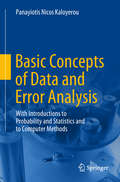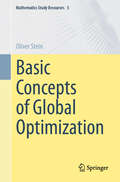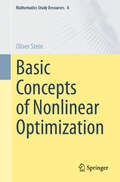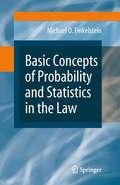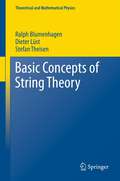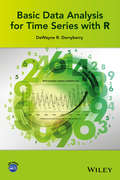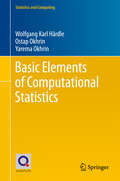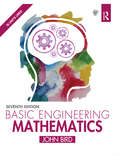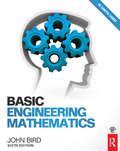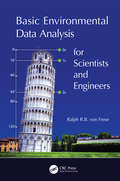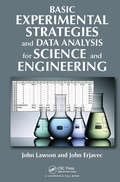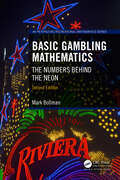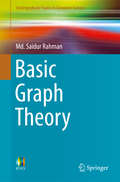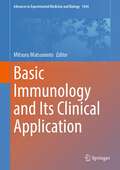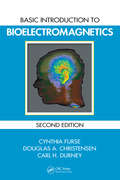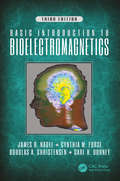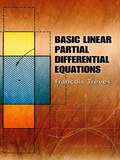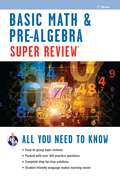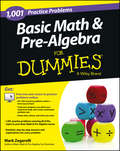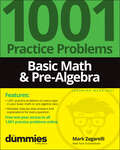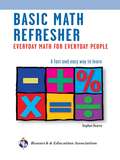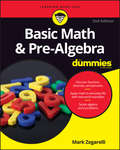- Table View
- List View
Basic Concepts of Data and Error Analysis: With Introductions to Probability and Statistics and to Computer Methods
by Panayiotis Nicos KaloyerouThis introductory textbook explains the concepts and methods of data and error analysis needed for laboratory experiment write-ups, especially physics and engineering experiments. The book contains the material needed for beginning students, e.g., first year university students, college students (enrolled on a certificate or diploma course) and even A-level students. Nevertheless, it also covers the required material for higher year university laboratories, including the final year. Only essential concepts and methods needed for the day-to-day performance of experiments and their subsequent analysis and presentation are included and, at the same time, presented as simply as possible. Non-essential detail is avoided. Chapter five is a stand-alone introduction to probability and statistics aimed at providing a theoretical background to the data and error analysis chapters one to four. Computer methods are introduced in Chapter six. The author hopes this book will serve as a constant reference.
Basic Concepts of Global Optimization (Mathematics Study Resources #5)
by Oliver SteinThis textbook is an introduction to global optimization, which treats mathematical facts stringently on the one hand, but also motivates them in great detail and illustrates them with 80 figures. The book is therefore not only aimed at mathematicians, but also at natural scientists, engineers and economists who want to understand and apply mathematically sound methods in their field. With almost two hundred pages, the book provides enough choices to use it as a basis for differently designed lectures on global optimization. The detailed treatment of the global solvability of optimization problems under application-relevant conditions sets a new accent that enriches the stock of previous textbooks on optimization. Using the theory and algorithms of smooth convex optimization, the book illustrates that the global solution of a class of optimization problems frequently encountered in practice is efficiently possible, while for the more difficult-to-handle non-convex problems itdevelops in detail the ideas of branch-and-bound methods. This book is the English translation of the 2nd edition of “Grundzüge der Globalen Optimierung” (Springer, 2021) written in German. The translation was done with the help of artificial intelligence. A subsequent revision was performed by the author to further refine the work and to ensure that the translation is appropriate concerning content and scientific correctness. It may, however, read stylistically different from a conventional translation.
Basic Concepts of Nonlinear Optimization (Mathematics Study Resources #8)
by Oliver SteinThis textbook is an introduction to nonlinear optimization, which treats mathematical concepts stringently on the one hand, but also motivates them in great detail and illustrates them with 42 figures. Therefore, the book is not only aimed at mathematicians, but also at natural scientists, engineers, and economists who want to understand and apply mathematically sound methods in their field. With just over two hundred pages, the book offers sufficient flexibility to serve as a foundation for various types of lectures on nonlinear optimization. Many geometric approaches for understanding both optimality conditions and numerical methods introduce a new perspective, enriching the existing literature on optimization. This is particularly evident in the detailed treatment of issues arising from different functional descriptions of the same geometry of feasible sets, and the thus motivated introduction of constraint qualifications for deriving derivative-based optimality conditions. This book is the English translation of the second edition of “Grundzüge der Nichtlinearen Optimierung” (Springer, 2021) written in German. The translation was done with the help of artificial intelligence. A subsequent revision was performed by the author to further refine the work and to ensure that the translation is appropriate concerning content and scientific correctness. It may, however, read stylistically different from a conventional translation.
Basic Concepts of Probability and Statistics in the Law
by Michael O. FinkelsteinThis book sets out basic statistical tools as they have been applied in actual legal disputes. Examples range over diverse fields of law, such as identification evidence, mass torts, securities law, environmental regulation, and capital punishment, among many others. In some notable cases, such as the U.S. Supreme Court's decision in Bush v. Gore, the book explores aspects of the statistical evidence that were unrecognized or misconceived by the parties or the court. For the statistics student, the book will give a deeper appreciation of foundation concepts and provide a wealth of real life applications. For the lawyer, or law student, the book will introduce a subject that has become increasingly important both in litigation and in studies of the legal system. The book is self-contained and may be read without background in probability or statistics.
Basic Concepts of String Theory (Theoretical and Mathematical Physics)
by Dieter Lüst Ralph Blumenhagen Stefan TheisenThe purpose of this book is to thoroughly prepare the reader for research in string theory at an intermediate level. As such it is not a compendium of results but intended as textbook in the sense that most of the material is organized in a pedagogical and self-contained fashion. Beyond the basics, a number of more advanced topics are introduced, such as conformal field theory, superstrings and string dualities - the text does not cover applications to black hole physics and cosmology, nor strings theory at finite temperatures. End-of-chapter references have been added to guide the reader wishing to pursue further studies or to start research in well-defined topics covered by this book.
Basic Data Analysis for Time Series with R
by DeWayne R. DerryberryWritten at a readily accessible level, Basic Data Analysis for Time Series with R emphasizes the mathematical importance of collaborative analysis of data used to collect increments of time or space. Balancing a theoretical and practical approach to analyzing data within the context of serial correlation, the book presents a coherent and systematic regression-based approach to model selection. The book illustrates these principles of model selection and model building through the use of information criteria, cross validation, hypothesis tests, and confidence intervals. Focusing on frequency- and time-domain and trigonometric regression as the primary themes, the book also includes modern topical coverage on Fourier series and Akaike's Information Criterion (AIC). In addition, Basic Data Analysis for Time Series with R also features: Real-world examples to provide readers with practical hands-on experience Multiple R software subroutines employed with graphical displays Numerous exercise sets intended to support readers understanding of the core concepts Specific chapters devoted to the analysis of the Wolf sunspot number data and the Vostok ice core data sets
Basic Elements of Computational Statistics (Statistics and Computing)
by Wolfgang Karl Härdle Ostap Okhrin Yarema OkhrinThis textbook on computational statistics presents tools and concepts of univariate and multivariate statistical data analysis with a strong focus on applications and implementations in the statistical software R. It covers mathematical, statistical as well as programming problems in computational statistics and contains a wide variety of practical examples. In addition to the numerous R sniplets presented in the text, all computer programs (quantlets) and data sets to the book are available on GitHub and referred to in the book. This enables the reader to fully reproduce as well as modify and adjust all examples to their needs. The book is intended for advanced undergraduate and first-year graduate students as well as for data analysts new to the job who would like a tour of the various statistical tools in a data analysis workshop. The experienced reader with a good knowledge of statistics and programming might skip some sections on univariate models and enjoy the various ma thematical roots of multivariate techniques. The Quantlet platform quantlet. de, quantlet. com, quantlet. org is an integrated QuantNet environment consisting of different types of statistics-related documents and program codes. Its goal is to promote reproducibility and offer a platform for sharing validated knowledge native to the social web. QuantNet and the corresponding Data-Driven Documents-based visualization allows readers to reproduce the tables, pictures and calculations inside this Springer book.
Basic Engineering Mathematics
by John BirdNow in its seventh edition, Basic Engineering Mathematics is an established textbook that has helped thousands of students to succeed in their exams. Mathematical theories are explained in a straightforward manner, being supported by practical engineering examples and applications in order to ensure that readers can relate theory to practice. The extensive and thorough topic coverage makes this an ideal text for introductory level engineering courses. This title is supported by a companion website with resources for both students and lecturers, including lists of essential formulae, multiple choice tests, and full solutions for all 1,600 further questions.
Basic Engineering Mathematics, 6th ed
by John BirdIntroductory mathematics written specifically for students new to engineering Now in its sixth edition, Basic Engineering Mathematics is an established textbook that has helped thousands of students to succeed in their exams. John Bird's approach is based on worked examples and interactive problems. This makes it ideal for students from a wide range of academic backgrounds as the student can work through the material at their own pace. Mathematical theories are explained in a straightforward manner, being supported by practical engineering examples and applications in order to ensure that readers can relate theory to practice. The extensive and thorough topic coverage makes this an ideal text for introductory level engineering courses. This title is supported by a companion website with resources for both students and lecturers, including lists of essential formulae, multiple choice tests, full solutions for all 1,600 further questions contained within the practice exercises, and biographical information on the 25 famous mathematicians and engineers referenced throughout the book. The companion website for this title can be accessed from www.routledge.com/cw/bird
Basic Environmental Data Analysis for Scientists and Engineers
by Ralph R.B. Von FreseClassroom tested and the result of over 30 years of teaching and research, this textbook is an invaluable tool for undergraduate and graduate data analysis courses in environmental sciences and engineering. It is also a useful reference on modern digital data analysis for the extensive and growing community of Earth scientists and engineers. Basic Environmental Data Analysis for Scientists and Engineers introduces practical concepts of modern digital data analysis and graphics, including numerical/graphical calculus, measurement units and dimensional analysis, error propagation and statistics, and least squares data modeling. It emphasizes array-based or matrix inversion and spectral analysis using the fast Fourier transform (FFT) that dominates modern data analysis. Divided into two parts, this comprehensive hands-on textbook is excellent for exploring data analysis principles and practice using MATLAB®, Mathematica, Mathcad, and other modern equation solving software. Part I, for beginning undergraduate students, introduces the basic approaches for quantifying data variations in terms of environmental parameters. These approaches emphasize uses of the data array or matrix, which is the fundamental data and mathematical processing format of modern electronic computing. Part II, for advanced undergraduate and beginning graduate students, extends the inverse problem to least squares solutions involving more than two unknowns. Features: Offers a uniquely practical guide for making students proficient in modern electronic data analysis and graphics Includes topics that are not explained in any existing textbook on environmental data analysis Data analysis topics are very well organized into a two-semester course that meets general education curriculum requirements in science and engineering Facilitates learning by beginning each chapter with an ‘Overview’ section highlighting the topics covered, and ending it with a ‘Key Concepts’ section summarizing the main technical details that the reader should have acquired Indexes many numerical examples for ready access in the classroom or other venues serviced by electronic equation solvers like MATLAB®, Mathematica, Mathcad, etc. Offers supplemental exercises and materials to enhance understanding the principles and practice of modern data analysis
Basic Experimental Strategies and Data Analysis for Science and Engineering
by John Lawson John ErjavecEvery technical investigation involving trial-and-error experimentation embodies a strategy for deciding what experiments to perform, when to quit, and how to interpret the data. This handbook presents several statistically derived strategies which are more efficient than any intuitive approach and will get the investigator to their goal with the fewest experiments, give the greatest degree of reliability to their conclusions, and keep the risk of overlooking something of practical importance to a minimum. Features: Provides a comprehensive desk reference on experimental design that will be useful to practitioners without extensive statistical knowledge Features a review of the necessary statistical prerequisites Presents a set of tables that allow readers to quickly access various experimental designs Includes a roadmap for where and when to use various experimental design strategies Shows compelling examples of each method discussed Illustrates how to reproduce results using several popular software packages on a companion web site Following the outlines and examples in this book should quickly allow a working professional or student to select the appropriate experimental design for a research problem at hand, follow the design to conduct the experiments, and analyze and interpret the resulting data. John Lawson and John Erjavec have a combined 25 years of industrial experience and over 40 years of academic experience. They have taught this material to numerous practicing engineers and scientists as well as undergraduate and graduate students.
Basic Gambling Mathematics: The Numbers Behind the Neon, Second Edition (AK Peters/CRC Recreational Mathematics Series)
by Mark BollmanBasic Gambling Mathematics: The Numbers Behind the Neon, Second Edition explains the mathematics involved in analyzing games of chance, including casino games, horse racing and other sports, and lotteries. The book helps readers understand the mathematical reasons why some gambling games are better for the player than others. It is also suitable as a textbook for an introductory course on probability. Along with discussing the mathematics of well-known casino games, the author examines game variations that have been proposed or used in actual casinos. Numerous examples illustrate the mathematical ideas in a range of casino games while end-of-chapter exercises go beyond routine calculations to give readers hands-on experience with casino-related computations. New to the Second Edition Thorough revision of content throughout, including new sections on the birthday problem (for informal gamblers) and the Monty Hall problem, as well as an abundance of fresh material on sports gambling Brand new exercises and problems A more accessible level of mathematical complexity, to appeal to a wider audience.
Basic Geometry
by Richard G. Brown Ray C. JurgensenTopics covered in this book include: points, lines, angles, introducing proof, triangles, using congruent triangles, polygons among others.
Basic Graph Theory (Undergraduate Topics in Computer Science)
by Md. Saidur RahmanThis undergraduate textbook provides an introduction to graph theory, which has numerous applications in modeling problems in science and technology, and has become a vital component to computer science, computer science and engineering, and mathematics curricula of universities all over the world. The author follows a methodical and easy to understand approach. Beginning with the historical background, motivation and applications of graph theory, the author first explains basic graph theoretic terminologies. From this firm foundation, the author goes on to present paths, cycles, connectivity, trees, matchings, coverings, planar graphs, graph coloring and digraphs as well as some special classes of graphs together with some research topics for advanced study. Filled with exercises and illustrations, Basic Graph Theory is a valuable resource for any undergraduate student to understand and gain confidence in graph theory and its applications to scientific research, algorithms and problem solving.
Basic Immunology and Its Clinical Application (Advances in Experimental Medicine and Biology #1444)
by Mitsuru MatsumotoThis book overviews ongoing and upcoming clinical applications of basic immunology. Recent advances in our knowledge of immunology coupled with new technologies have aided in the development of efficient cancer immunotherapy, as well as the control of emerging microorganisms such as SARS-CoV-2. However, knowledge of basic immunology has not been fully utilized even after the discoveries of immune checkpoint inhibition for cancer immunotherapy and the development of mRNA vaccination against SARS-CoV-2. There is still room for improving the clinical application of basic immunology. The book summarizes the achievements in clinical applications of basic immunology and highlights what can be further extended to make immunology a more practical human science. Basic immunology and its clinical applications are two wheels of the same cart in the immunology field, which aids in the development of more efficient cancer immunotherapy and rapid control of infectious diseases against microorganisms, including new viruses and classical toxoplasmosis. The exploration of ongoing and upcoming applications of basic immunology in this book makes it a useful resource for immunologists, physicians, molecular and genome biologists, bioinformaticians, and students in these fields.
Basic Introduction to Bioelectromagnetics
by Cynthia Furse Douglas A. Christensen Carl H. DurneyAlthough classical electromagnetic (EM) field theory is typically embedded in vector calculus and differential equations, many of the basic concepts and characteristics can be understood with precursory mathematical knowledge. Completely revised and updated, Basic Introduction to Bioelectromagnetics, Second Edition facilitates the process of interd
Basic Introduction to Bioelectromagnetics, Third Edition
by James Nagel Cynthia Furse Douglas A. Christensen Carl H. DurneyBasic Introduction to Bioelectromagnetics, Third Edition, is a primary source for medical technologists and life scientists seeking to understand how electromagnetic fields interact with the body, and how they are used in medical applications. Instead of the complex math commonly used when analyzing electromagnetics, this book uses graphical methods and simple equations. The third edition is updated with color graphics that show the fields in bright, clear colors. Each concept is presented with an associated discussion and application, including MRI, NMR, hyperthermia, neural stimulation, ultrasound, and cardiac pacing/defibrillation. Offering a simplified explanation of a very complex subject, this third edition provides an accessible introduction for life scientists and medical technologist on how EM fields work, what controls them, and the factors important to experimental setups and medical applications. This qualitative and illustrative book: Covers the entire frequency spectrum from direct current (DC) up through optical frequencies. Includes more than 200 illustrations, 65 in color, and 40 medical applications. Incorporates examples from real-world applications to explain concepts. Concentrates on the qualitative explanation of the key concepts, fundamental principles, and characteristic behaviors of EM fields, without complicated mathematics. Offers practical rules of thumb to understand real situations. Requires only a background in algebra, in contrast to typical EM books that require vector calculus and differential equations.
Basic Linear Partial Differential Equations
by Francois TrevesFocusing on the archetypes of linear partial differential equations, this text for upper-level undergraduates and graduate students features most of the basic classical results. The methods, however, are decidedly nontraditional: in practically every instance, they tend toward a high level of abstraction. This approach recalls classical material to contemporary analysts in a language they can understand, as well as exploiting the field's wealth of examples as an introduction to modern theories.The four-part treatment covers the basic examples of linear partial differential equations and their fundamental solutions; the Cauchy problem; boundary value problems; and mixed problems and evolution equations. Nearly 400 exercises appear throughout the text, several containing detailed information that enables readers to reconstruct the proofs.
Basic Math & Pre-Algebra Super Review (Super Reviews Study Guides)
by The Editors of REANeed help with Basic Math and Pre-Algebra? Want a quick review or refresher for class? This is the book for you! REA's Basic Math and Pre-Algebra Super Review gives you everything you need to know! This Super Review can be used as a supplement to your high school or college textbook, or as a handy guide for anyone who needs a fast review of the subject. * Comprehensive, yet concise coverage - review covers the material that is typically taught in a beginning-level math and pre-algebra course. Each topic is presented in a clear and easy-to-understand format that makes learning easier. * Packed with practice - each review lesson is packed with practice questions and answers for each topic. Practice what you've learned and build your basic math and pre-algebra skills, so you'll be ready for any problem you encounter on your next quiz or test. * Detailed answers - our practice problems come with step-by-step detailed solutions to help you understand the material and sharpen your skills. Whether you need a quick refresher on the subject, or are prepping for your next exam, we think you'll agree that REA's Super Review provides all you need to know!
Basic Math & Pre-Algebra: 1,001 Practice Problems For Dummies (+ Free Online Practice) (For Dummies Series)
by Mark Zegarelli1001 Basic Math & Pre- Algebra Practice Problems For Dummies Practice makes perfect--and helps deepen your understanding of basic math and pre-algebra by solving problems1001 Basic Math & Pre-Algebra Practice Problems For Dummies, with free access to online practice problems, takes you beyond the instruction and guidance offered in Basic Math & Pre-Algebra For Dummies, giving you 1,001 opportunities to practice solving problems from the major topics in your math course. You begin with some basic arithmetic practice, move on to fractions, decimals, and percents, tackle story problems, and finish up with basic algebra. Every practice question includes not only a solution but a step-by-step explanation. From the book, go online and find:One year free subscription to all 1001 practice problemsOn-the-go access any way you want it--from your computer, smart phone, or tabletMultiple choice questions on all you math course topics Personalized reports that track your progress and help show you where you need to study the most Customized practice sets for self-directed study Practice problems categorized as easy, medium, or hardThe practice problems in 1001 Basic Math & Pre-Algebra Practice Problems For Dummies give you a chance to practice and reinforce the skills you learn in class and help you refine your understanding of basic math & pre-algebra.Note to readers: 1,001 Basic Math & Pre-Algebra Practice Problems For Dummies, which only includes problems to solve, is a great companion to Basic Math & Pre-Algebra I For Dummies, which offers complete instruction on all topics in a typical Basic Math & Pre-Algebra course.
Basic Math & Pre-Algebra: 1001 Practice Problems For Dummies (+ Free Online Practice)
by Mark ZegarelliPractice makes perfect—gain math mastery with Dummies Basic Math & Pre-Algebra: 1001 Practice Problems For Dummies gives you 1,001 opportunities to practice solving problems on all the major topics in middle-grade math and Pre-Algebra—in the book and online! Get extra practice with tricky subjects, solidify what you’ve already learned, and get in-depth walk-throughs for every problem with this useful book. These practice problems and detailed answer explanations will improve your mathemagic abilities, no matter what your skill level is now. Thanks to Dummies, you have a resource to help you put key concepts into practice. Work through practice problems on all middle-grade and Pre-Algebra topics covered in class Step through detailed solutions to build your understanding Access practice questions online to study anywhere, any time Improve your grade and up your study game with practice, practice, practiceThe material presented in Basic Math & Pre-Algebra: 1001 Practice Problems For Dummies is an excellent resource for students, as well as parents and tutors looking to help supplement clasroom instruction. Basic Math & Pre-Algebra: 1001 Practice Problems For Dummies (9781119883500) was previously published as 1,001 Basic Math & Pre-Algebra Practice Problems For Dummies (9781118446560). While this version features a new Dummies cover and design, the content is the same as the prior release and should not be considered a new or updated product.
Basic Math Refresher, 2nd Ed.: Everyday Math for Everyday People
by Stephen HearneDo You Need Extra Help with Math? Then REA's Basic Math Refresher is perfect for you! Updated Second Edition REA's newest edition of our popular Basic Math Refresher helps students and adults refresh their math knowledge in a fast and easy-to-understand format. It's everyday math for everyday people. Citing real-life situations and using hundreds of example problems, Stephen Hearne's Basic Math Refresher is perfect for anyone who needs to grasp the concepts of basic mathematics. It's a fast and easy way to learn basic math! This handy reference book explains the basics of commonly used math topics, including addition, decimals, percentages, fractions, averages, sales tax, and more. It's a great tool to have on hand when preparing for homework, quizzes, or exams. If you are an adult who wants to brush up on your math skills you'll find it an easy-to-use resource. The book includes hundreds of math examples solved step-by-step and a glossary of must-know math terms. Each chapter is devoted to a specific math topic and explains basic math functions in a simple style. Numerous examples show students and adults how to solve math problems quickly and correctly. Basic Math Refresher is an excellent classroom reference book and/or textbook supplement. The easy-to-follow format is perfect for middle school, high school, and college students who need a simple math refresher. Adults who need help with basic math will view it as a practical guide to math concepts they have forgotten or never fully grasped in school. If you're math phobic, or just need to refresh your math skills, this book is for you!
Basic Math Review for Statistics Students
by Zealure C. HolcombStatistics and mathematics share a common language and computational procedures. For various reasons, some young students do not master basic elements in mathematics. Unless remediated early, students can get caught up in an unfortunate cycle in which failure to master the basics leads to failure at higher levels. This book breaks the cycle by providing a fresh chance to learn the essentials underlying achievement in the computational aspects of statistics.
Basic Math Review for Statistics Students
by Zealure C. HolcombProvides a fresh start for students to learn the essentials underlying achievement in the computational aspects of statistics.
Basic Math and Pre-Algebra For Dummies
by Mark ZegarelliTips for simplifying tricky basic math and pre-algebra operationsWhether you're a student preparing to take algebra or a parent who wants or needs to brush up on basic math, this fun, friendly guide has the tools you need to get in gear. From positive, negative, and whole numbers to fractions, decimals, and percents, you'll build necessary math skills to tackle more advanced topics, such as imaginary numbers, variables, and algebraic equations.Explanations and practical examples that mirror today's teaching methodsRelevant cultural vernacular and referencesStandard For Dummies materials that match the current standard and designBasic Math & Pre-Algebra For Dummies takes the intimidation out of tricky operations and helps you get ready for algebra!
